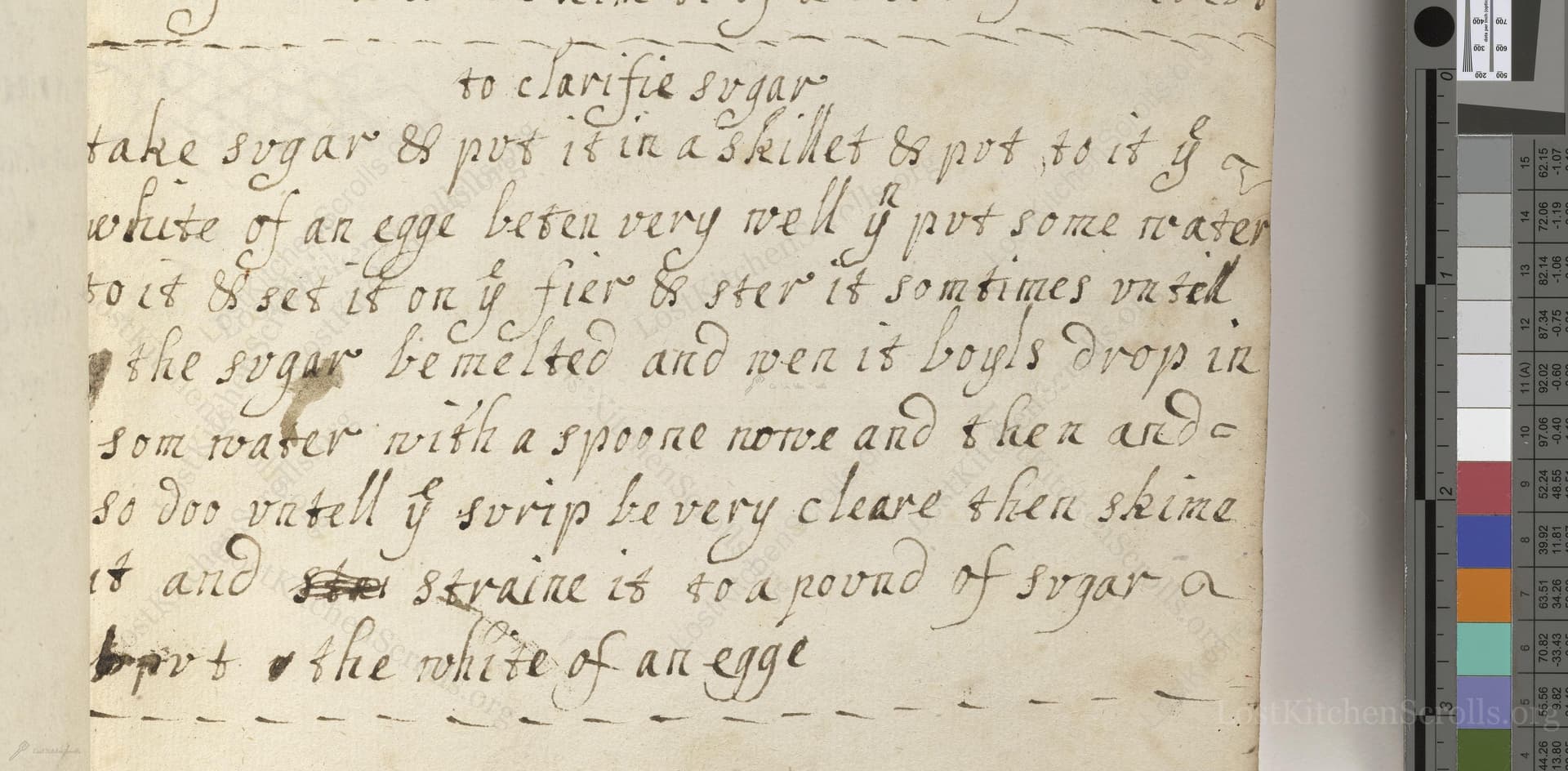To Clarifie Sugar
From the treasured pages of Culinary and medicinal recipe book of Mary Smith
Written by Mary Smith

To Clarifie Sugar
"take sugar & put it in a skillet & put to it ye white of an egge beten very well & put some water to it & Set it on ye fier & ster it sometimes vatell ye sugar be melted and wen it boyls drop in som water with a spoone now and then & so doo vatell ye Syrrup be very cleare then skime it and & straine it to a pound of sugar a part of the white of an egge"
Note on the Original Text
This recipe is written in typical 17th-century English, marked by creative spelling and a casual, conversational tone. 'Clarifie' means 'clarify,' and 'beten' is 'beaten.' 'Vatell' is likely 'until.' The writer uses '&' for 'and,' and measures are loose, suggesting an experienced cook's intuition. Testing with a 'spoone' and 'boyling' are familiar kitchen actions of the era. Recipes were often short and direct, assuming prior knowledge of the process.

Title
Culinary and medicinal recipe book of Mary Smith (1662)
You can also click the book image above to peruse the original tome
Writer
Mary Smith
Era
1662
Publisher
Unknown
Background
A delightful window into 17th-century kitchens, this cookbook serves up recipes and culinary wisdom from a bygone era, inviting readers to savor the flavors and traditions of the past.
Kindly made available by
Folger Shakespeare Library
This recipe originates from the manuscript of Mary Smith, dating to around 1662, in England. During this period, sugar was commonly sold in large, impure loaves, requiring clarification to remove molasses and debris. Clarifying sugar was essential for elegant confections, preserves, and syrups, and was a domestic art practiced by the well-to-do or their kitchen staff. The use of egg white as a clarifying agent was a widespread culinary technique in historical Europe, as proteins in the egg white trap impurities and help them rise to the surface, making them easy to remove.

In the 17th century, the sugar would have been clarified in a brass or copper skillet or pan, over an open hearth or charcoal chafing stove. A wooden spoon was used for stirring. Cooks would drop spoonsful of syrup into water, possibly in earthenware or pewter bowls, to test for clarity. Skimming was done with a small ladle or spoon, and the clarified syrup could be strained through muslin, linen cloth, or a sieve.
Prep Time
5 mins
Cook Time
20 mins
Servings
10
We've done our best to adapt this historical recipe for modern kitchens, but some details may still need refinement. We warmly welcome feedback from fellow cooks and culinary historians — your insights support the entire community!
Ingredients
- 1 lb white granulated sugar
- 1/2 cup water
- 1 egg white (use about 1/2 oz per 1 lb sugar)
Instructions
- To clarify sugar as per this 17th-century method, take 1 pound (16 ounces) of plain white sugar and place it in a medium saucepan.
- Add about 1/2 cup of cold water.
- Whisk one egg white in a small bowl until frothy, then add roughly half the egg white (about 1/2 ounce) to the pan.
- Stir to combine the ingredients.
- Place the saucepan over medium heat, stirring occasionally, until the sugar dissolves.
- Allow the mixture to come gently to a boil, then periodically drop a small spoonful of the syrup into a glass of cold water.
- When the syrup appears clear and impurities have risen or collected, carefully skim off the foam or scum.
- Strain the clarified syrup through a fine sieve or cheesecloth for best results.
Estimated Calories
200 per serving
Cooking Estimates
It takes about 5 minutes to prepare the ingredients and 20 minutes to cook the sugar syrup. This recipe makes around 500 ml of clarified sugar syrup, enough for about 10 servings of 50 ml each. Each serving contains about 200 calories.
As noted above, we have made our best effort to translate and adapt this historical recipe for modern kitchens, taking into account ingredients nowadays, cooking techniques, measurements, and so on. However, historical recipes often contain assumptions that require interpretation.
We'd love for anyone to help improve these adaptations. Community contributions are highly welcome. If you have suggestions, corrections, or cooking tips based on your experience with this recipe, please share them below.
Join the Discussion
Rate This Recipe
Dietary Preference
Main Ingredients
Culinary Technique
Occasions

Den Bockfisch In Einer Fleisch Suppen Zu Kochen
This recipe hails from a German manuscript cookbook compiled in 1696, a time whe...

Die Grieß Nudlen Zumachen
This recipe comes from a rather mysterious manuscript cookbook, penned anonymous...

Ein Boudain
This recipe comes from an anonymous German-language manuscript cookbook from 169...

Ein Gesaltzen Citroni
This recipe, dating from 1696, comes from an extensive anonymous German cookbook...
Browse our complete collection of time-honored recipes



